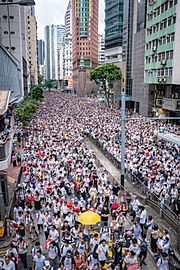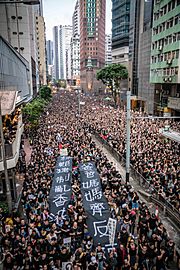2019–20 Hong Kong protests facts for kids
The 2019-20 Hong Kong anti-extradition bill protests were a series of large demonstrations in Hong Kong. These protests began because of a new law proposed by the Government of Hong Kong. This law was called the Fugitive Offenders and Mutual Legal Assistance in Criminal Matters Legislation (Amendment) Bill 2019.
Many people in Hong Kong and around the world were worried about this bill. They feared it would allow people in Hong Kong to be sent to mainland China for trials. This would mean they might face a different legal system.
People from all walks of life joined the protests. On June 9, 2019, over one million people marched in the streets. This huge protest was organized by the Civil Human Rights Front (CHRF). People from Hong Kong living overseas also held protests.
At first, the government wanted to pass the bill. They said it was important to fix a legal "loophole." But because of the massive protests, the government changed its mind. On June 15, 2019, Carrie Lam, the leader of Hong Kong, announced the bill would be put on hold.
Later, on September 4, the government promised to officially withdraw the bill. It was formally taken back on October 23, 2019.
Contents
Why People Protested
Understanding the Extradition Bill
The proposed law would have allowed Hong Kong to send people accused of crimes to places it didn't have extradition agreements with. This included mainland China. People were concerned because China's legal system is very different from Hong Kong's.
Many worried that this bill could be used to target political activists. They feared it would reduce Hong Kong's independence. Hong Kong has its own laws under the "One Country, Two Systems" rule.
Concerns About Freedom
People in Hong Kong value their freedoms. These include freedom of speech and the right to protest. They worried that the new law would threaten these rights. Many saw it as a step towards China having more control over Hong Kong.
The protests were not just about the bill itself. They also showed a deeper concern for Hong Kong's future. People wanted to protect their way of life and their unique legal system.
Key Moments of the Protests
The Million-Person March
The protest on June 9, 2019, was one of the biggest. Over a million people marched peacefully. They wore white clothes to show their unity. This event showed the government how strongly people felt.
Government Response
Despite the large protests, the government initially pushed for the bill. This made many people even angrier. The protests continued and grew larger.
On June 15, Carrie Lam announced the bill's suspension. This meant it would not be passed for now. However, protesters wanted the bill to be fully withdrawn, not just suspended.
Withdrawal of the Bill
The protests continued for months. Finally, on September 4, the government promised to formally withdraw the bill. This happened on October 23, 2019. While the bill was withdrawn, the protests continued for other demands.
What Happened Next
Ongoing Demands
Even after the bill was withdrawn, many protesters had other demands. These included:
- An independent investigation into police actions during the protests.
- Releasing arrested protesters.
- Calling the protests a "movement," not "riots."
- Allowing people to vote for their leaders.
Impact on Hong Kong
The protests had a big impact on Hong Kong. They showed the world the strong desire for democracy and freedom. They also led to many discussions about Hong Kong's relationship with mainland China.
The events also led to new laws being introduced later. These laws changed how protests could happen in Hong Kong. The protests remain a very important part of Hong Kong's recent history.
Images for kids
-
Police used tear gas to disperse protesters gathering outside the Legislative Council Complex on 12 June 2019.
-
Protesters in Yau Ma Tei on 18 November 2019 as they attempted to breach the police's cordon line to break through to protesters trapped inside Hong Kong Polytechnic University
-
The national security law banned anyone from shouting or displaying the slogan "Liberate Hong Kong, the revolution of our times" (Chinese: 光復香港,時代革命), which has achieved mainstream adoption since July 2019.
-
Former lawmaker Nathan Law met with US Secretary of State Mike Pompeo in July 2020, discussing matters concerning the national security law, the pro-democratic primaries, and the LegCo election.
-
Pepe the Frog became a symbol of resistance during the protests. "Give me Liberty or Give me Death!" alludes to Patrick Henry's speech in support of the American Revolution.
-
A Winnie the Pooh toy used to symbolise Xi Jinping with the Chinazi flag stuck on it and a swastika shaped Chinese Flag attached on its chest, used in the 1 December 2019 protests
-
Protesters adopted the black bloc method and wore helmets and respirators to protect themselves. Yellow hard hats became a symbol for the protest movement
-
A "smart" lamppost was destroyed by protesters on 24 August 2019, due to understanding that it could be used for surveillance
-
Protest at the Hong Kong International Airport on 26 July 2019
-
Activists including Joshua Wong and Nathan Law met House Democratic leader Nancy Pelosi and Representative Chris Smith at the US Congress.
Want to Learn More?
See also
 In Spanish: Protestas en Hong Kong de 2019-2021 para niños
In Spanish: Protestas en Hong Kong de 2019-2021 para niños

























